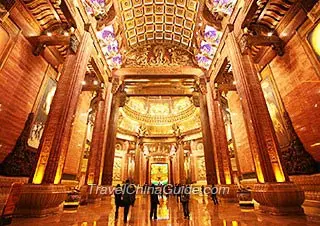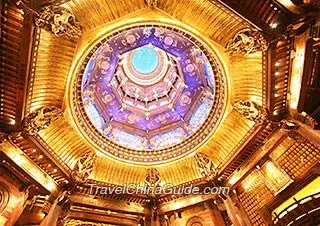Mt. Lingshan Grand Buddha Scenic Area
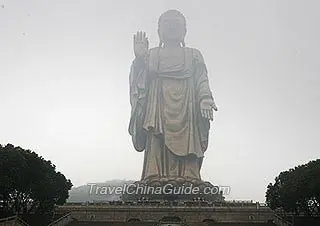 |
The majority of the attractions extend along a southeast-northwest axis from the main gate to the Grand Buddha statue with some sights to the east. Here is a recommended itinerary for you to fully enjoy the scenic area.
Entrance → Grand Screen Wall → Altar of Buddha’s Footprints → Nine Dragons Bathing Sakyamuni → Buddha’s Hand Square → Xiangfu Temple → Ancient Ginkgo Square → Grand Buddha → Brahma Palace → Flying Dragon Tower → Five Mudra Mandala → Exit
Grand Screen Wall
Altar of Buddha’s Footprints
To the northwest of the altar is the Five Wisdoms Gate, a stone archway with delicate handmade engravings. Go through the gate, and you will be on the broad Bodhi Avenue leading to a highlight of the Mt. Lingshan Scenic Area - the square with the music fountain of Nine Dragons Bathing Sakyamuni.
Nine Dragons Bathing Sakyamuni
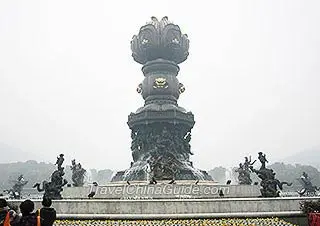 |
| Nine Dragons Bathing Sakyamuni |
Follow the seven lotuses pattern decorated on the axis of Bodhi Avenue, and you will see the music fountain reproducing the miraculous scene of the birth of Sakyamuni. There is a round pool with a giant bronze lotus with its six pedals closed. When the music ‘Birth of Buddha’ plays, the lotus gently blooms, with a 7.2-meter (23.6-feet) gilded statue of Sakyamuni rising from the center. The nine dragons around the pool spout water to give Sakyamuni a bath, and the statue revolves 360 degrees. The lotus closes when the music fades out, and then pure water comes out from the mouths of the eight phoenixes around the pool. It is said that you and your family will be blessed if you drink the water.
Around this square, there is a corridor with 108 prayer wheels. Walk the circuit, roll them, and Buddha will see your piety and bless you.
Go through the square, and you will see a giant bronze relief with a width of 26 meters (85 feet) and a height of 8 meters (26 feet), vividly describing the difficulties Sakyamuni faced during his Buddhist practice and his final enlightenment.
Continue to go forth; you will see the Ashoka Pillar, a granite pillar with a height of 16.9 meters (55.4 feet) and a weight of over 200 tons. It is the symbol of the spread of Buddhism from ancient India.
Ashoka, an Indian emperor who ruled the Maurya Dynasty from 269 to 232 BC, was a fearsome warrior in his youth and became a Buddhist in his old age. He set up numerous stone pillars engraved with Buddhist scriptures for common people to learn. Also, he sent envoys to spread Buddhism to neighboring countries, and thus made a great contribution to the present popularity of the religion.
Buddha’s Hand Square
Xiangfu Temple
In front of the temple, there are three bridges - Pudu Bridge, Dajue Bridge and Ci’en Bridge - standing for self-conscious cultivation, apprehension, and repayment of obligations. The Hall of Heavenly Kings is just at the entrance. Maitreya is worshiped inside and the statues of four heaven kings by the two sides symbolize the timely wind and rain, and peace of the people and the state. Behind the hall, there are a bell tower and a drum tower. The largest bell in south China is kept here. Each New Year’s Eve and Spring Festival’s Eve, a bell-ringing ceremony is held. According to the Buddhist scriptures, the tolling of the bells dispels worries and helps one gain wisdom. There is also a Buddha statue with a height of 8 meters (26 feet), which is the model of the 88-meters’ (289-feet) Grand Buddha. The Mahavira Hall just behind is the grandest building in the temple, holding the sculptures of Sakyamuni, his followers and 16 arhats.
Ancient Ginkgo Square
The Wujinyi Pavilion next to the temple is set as a memorial for Zhao Puchu, the former leader of the China Buddhism Association and a famous community leader. Some precious Buddhist documents and souvenirs are exhibited.
Grand Buddha
When you finish ascending the long stairs, you will know true majesty and greatness at the foot of the Grand Buddha. The 88-meter (289 feet) high statue has as a background Small Lingshan Mountain, with Green Dragon Mountain on the left and White Tiger Mountain on the right. As the world’s largest bronze statue of Sakyamuni, it stands proudly with the four other giant Buddha statues located in the Yungang Caves of Datong, the Longmen Caves in Luoyang, at Leshan in Sichuan, and at the Temple of Heaven in Hong Kong.
The statue and its lotus pedestal are made of 2,000 sheets of bronze, weighing over 725 tons. An advanced lightning protection system is used to protect the statue and many high technologies ensure that it is wind-proof, quake-proof and un-corroded.
The right hand of Buddha, which points up to heaven, is in the ‘Fearless Mudra’ enabling people to be brave and peaceful in mind. The right hand pointing down to the earth shows the ‘Benefaction Mudra’, blessing all flesh with safety and happiness. Looking at the statue, one will find that the eyes of the Buddha always follow you whether you are far from or near the statue. How miraculous it is! This interesting phenomenon is actually due to the exceptional skills of the sculptors.
Inside the pedestal of the statue is a comprehensive three-floored museum showing the essentials of Buddhism. The Buddhism Culture Museum on the first floor displays the origin, spread, development, sects and art of this religion in China and also its profound influence on Chinese culture. Carved out of precious ancient Nanmu wood, the museum is a model of the former Hall of 500 Arhats on Longevity Hill in the Summer Palace, Beijing. The Suixi Hall on the second floor houses Buddhist utensils, poems and paintings. The Ten-Thousand Buddhas Hall on the third floor holds a large number of small Buddha statues. The elevator inside can take you to the lotus pedestal where you can touch the feet of the Grand Buddha for safety and luck.
Brahma Palace
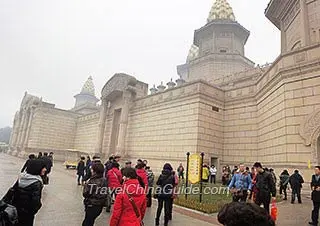 |
| Brahma Palace |
With a symmetrical layout, the palace is built of stone with grand halls, high porch pillars, wide girders and towering domes. The white jade elephant in the lobby is a sacred symbol in Buddhism. The huge oil paintings on the wall along the corridor show the spread, communication and development of Buddhism. The corridor and the inside tower hall are delicately decorated with exquisite Dongyang woodcarvings made from precious Nanmu wood. All the girders and columns are carved with auspicious patterns or Buddhist stories. There is an amazing huge mural painting called 'Celestial View’ on the vault of the tower hall. The Golden Wheel Buddha sits in the center of the painting, surrounded by the sun, moon and seven major planets, plus the zodiac. Twenty-eight ancient Chinese constellations are scattered among the circles. The whole painting, done in the Tang Dynasty style, shows an unearthly scene of heaven and exemplifies Buddhism's unique religious art. In addition, refined relief, first-class lacquer ware, cloisonné and porcelains are collected in the Brahma Palace. The most eye-catching is the treasure of the palace - a grand colored glaze craft work entitled ‘Worlds in the Lotus’.
|
|
A round multi-functional theatre is on the second floor. The theatre can hold 1,500 people. The drama ‘Ode to Auspice’ is performed here.
Sat., Sun.: 10:35, 11:30, 13:00, 14:00, 15:00, 16:00
On the third floor, there is a dining hall offering vegetarian food.
Flying Dragon Tower
Five Mudra Mandala
| Ticket Price | CNY 210 Children under 6 years old or under 1.2 meters in height are free of charge; Kids and teenagers aged between 6 and 18: CNY 105; Seniors aged between 60 and 70: CNY 160; Seniors aged above 70: CNY 90 |
| Opening Hours | Ticket Selling Time: 7:00 - 17:00 Brahma Palace: 9:00 - 18:00 Five Mudra Mandala: 9:30 - 18:00 Buddhism Culture Museum: 8:30 - 17:30 |
| Recommended Time for a Visit | One day |
| Rent for Audio Guide Device | CNY 20 (in English ) |
| Tour Guide Service | (offered by the scenic area) CNY 500 for 12 persons within 3 hours |
| Battery Car | 9:00 – 17:00 CNY 25 per person (Children under 1.2 meters high are free of charge); CNY 400 per car within 1.5 hours (for 12 persons) |
| Transportation | Bus no. 88 and 89 can take you to Mt. Lingshan Grand Buddha Scenic Area. If you come from Shanghai, Nanjing or Hangzhou, you can take a bullet train to Wuxi first and then take the bus no. 88. The taxi fare from Wuxi Railway Station to Mt. Lingshan is around CNY 100. |
| Dining | Lingshan Vegetarian Restaurant; Brahma Palace Buffet Dinner: 10:30 - 14:30 |
![]() Further Reading: Top 10 Things to Do in Wuxi
Further Reading: Top 10 Things to Do in Wuxi
- Last updated on Aug. 12, 2025 by Demi Li -
